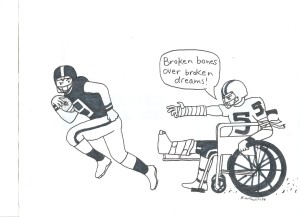An athlete’s best is expected day in and day out, but this expectation put on them from coaches, parents, and teammates causes athletes to crumble under this consistent pressure, causing unnecessary injuries.
A young, and growing body should not be getting injured regularly in order to succeed at practice. Of course high school athletics are important to each and every athlete, but there comes a point where an athlete needs to stop in order to prevent injuries.
High school athletes account for an estimated 2 million injuries, 500,000 doctor visits, and 30,000 hospitalizations each year, and overuse injuries are responsible for nearly half of all sports injuries to middle and high school students.
Nobody wants to let his/her team down, but at times coaches and teammates need to step in and stop an athlete if the risk of injury is present.
Every years, at least 10 children die from heat stroke during a sports game or practice, according to data from the National Center for Catastrophic Sport Injury Research. Dozens more suffer from heat stroke or heat exhaustion of the field.
Researchers collected data from 1982 to 2011 for all high school sports and millions of high school athletes. Total fatality rates were then calculated per 100,000 participants, according to the article “The Deadliest High School Sports,” on the Weather Channel’s website.
The deadliest sport during this time had a fatality rate of 2.89 deaths per 100,000, which was more than double the second deadliest sport. Football was the fourth deadliest sport with a fatality rate of .81 per 100,000 participants, according to statistics on stopsportsinjuries.org.
Still, cheerleading causes the most injuries out of any of the sports studied, as well as the most hospital visits. It does not have many fatalities, though only seven in 19 years, according to a separate 2011 report from the National Center for Catastrophic Sport Injury Research.
Cheerleading is a prime example of a sport that has recently changed in the past 15 years, becoming competitive and riskier each year. With these added skills to the sports and increase in pressure to succeed, athletes are pushed over the edge causing damage on their body that could potentially last a lifetime.
 A child’s life or future should not be put at risk in order to win the ‘big’ game. Awareness and prevention of high school sports injuries needs to be initiated to maintain the safety of high school athletes.
A child’s life or future should not be put at risk in order to win the ‘big’ game. Awareness and prevention of high school sports injuries needs to be initiated to maintain the safety of high school athletes.
